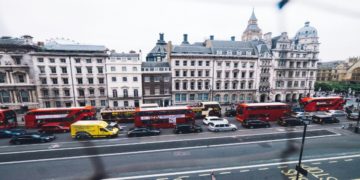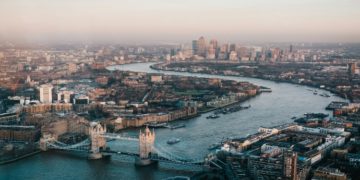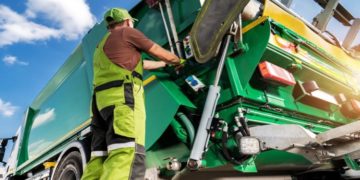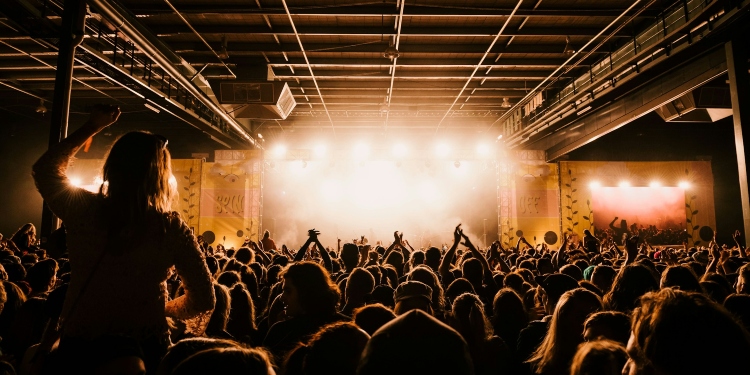In arenas, festivals and broadcast environments where seconds matter, large-scale inflatable sculptures achieve a rare alchemy: monumental presence with minimal mass, rapid deployment and repeatable precision.
The best inflatable design is not whimsy but strategy, an exacting blend of dramaturgy, silhouette legibility, engineering rigour, touring efficiency and sustainability. From the experimental air structures of the 1960s to today’s stadium-scale icons, inflatables have evolved into tour-grade set pieces that remain clear and recognisable whether viewed from the back row of an arena or through the lens of a broadcast camera. Contemporary inflatable artwork illustrates how refined fabrication, hand-crafted detail and technical assurance transform air and fabric into a medium of serious theatrical and artistic expression.
Concept and Silhouette, Designing the Icon
Great inflatable design begins long before fabric is cut. It originates in the conceptual stage, where narrative intent, character development and brand fidelity are distilled into a form that can command attention in vast spaces. Whether the brief is to conjure a mythical creature for a touring stage show or to replicate a luxury product at monumental scale for a brand launch, the design process must balance theatrical imagination with practical legibility.
At the heart of this lies silhouette. A successful inflatable must be instantly recognisable from a distance, its outline clear against stage lighting, LED backdrops or an open sky. Sightline studies ensure that every audience member, whether standing at the barriers or seated in the furthest tier, can interpret the figure with equal clarity. Designers frequently employ three- dimensional maquettes and digital pre-visualisation to test how proportions read in different venues and under different lighting conditions. By refining the silhouette in the design phase, the inflatable achieves a visual strength that transcends scale and remains memorable in both live and broadcast contexts.
Touring Grade Fabrication and Hand-Crafted Finish
The transition from design to performance depends on materials that are both lightweight and exceptionally durable. Touring inflatables are built from ripstop nylon, polyester reinforced composites or thermoplastic coatings, each chosen for tensile strength, tear resistance and flame-retardant certification that meets international venue standards. Seams are reinforced through radio frequency or hot air welding, and many sculptures use multi-chamber systems with internal baffles to maintain precise form and provide redundancy should one area lose pressure. These engineering choices allow the inflatable to endure the rigours of repeated inflations, rigging stress and global transport.
Equally important is the artistry of the finish. A hand-crafted approach allows for hyperreal textures or bold painterly strokes that transform the surface from simple fabric to theatrical canvas. UV-stable pigments protect colour under powerful stage lighting, while abrasion-resistant coatings ensure longevity across multiple tours. By combining rigorous engineering with meticulous hand painting, the inflatable achieves the balance of durability and spectacle that defines tour-ready design.
Safety, Air Systems and Rigging Assurance
No inflatable sculpture can be considered great without absolute confidence in its safety and operational reliability. Touring inflatables typically use sealed or continuous inflation systems, with high-efficiency blowers supported by redundant power supplies to prevent failure during performance. Internal pressure is carefully calibrated to account for environmental changes such as heat or wind, while multi-chamber designs allow controlled deflation if required. Noise attenuation is also essential, particularly in theatre or broadcast environments where air systems must remain discreet. These measures ensure that the inflatable maintains its form consistently while protecting performers, crew and audiences.
Rigging is equally critical. Load paths and anchoring points are designed to integrate seamlessly with truss systems, ensuring that the inflatable remains stable even during complex cues or rapid inflations. Comprehensive documentation, including risk assessments, method statements and inspection schedules, accompanies every installation. Specialist crews trained in both rigging and inflatable handling deliver and oversee these operations, providing fully insured installation that aligns with venue regulations. With these systems in place, large-scale inflatables function as secure and dependable elements of major productions.
Integration, Logistics and Sustainability
A great inflatable design is more than a static form. It must integrate seamlessly with the wider production, supporting lighting, projection mapping and show control systems. Sculptures are often treated as three-dimensional canvases, with edge lighting, video projection or digital content layered across their surfaces to enhance drama. When connected to DMX or Art Net protocols, inflatables can be inflated, deflated or illuminated in perfect synchrony with sound and motion cues, creating moments of spectacle that feel entirely woven into the narrative of the performance.
Touring logistics demand the same precision. Premium inflatables are engineered to strike quickly, with colour-coded rigging, quick-connect valves and optimised pack-out systems that reduce set-up time and freight volume. Maintenance protocols extend their life through careful cleaning, repairs and long-term storage. Equally significant is the commitment to sustainability. Many inflatables are designed for re-use across multiple productions, and when their life cycle ends, sustainable recycling options are available to minimise environmental impact. This approach preserves both artistic value and ecological responsibility, ensuring that air made monumental does not come at the cost of the planet.
Conclusion
The measure of a great inflatable design lies in its ability to merge artistry with engineering, creating a form that is visually commanding, safe to operate and efficient to tour. From the clarity of its silhouette to the integrity of its hand-crafted finish, every decision shapes how audiences experience the spectacle. Supported by robust air systems, secure rigging and sustainable life-cycle planning, inflatable sculptures have become indispensable to the language of live performance and large-scale events. They offer a unique synthesis of imagination and practicality, proving that air and fabric, when expertly realised, can rival steel and stone in their capacity to inspire awe.
David Prior
David Prior is the editor of Today News, responsible for the overall editorial strategy. He is an NCTJ-qualified journalist with over 20 years’ experience, and is also editor of the award-winning hyperlocal news title Altrincham Today. His LinkedIn profile is here.














































































